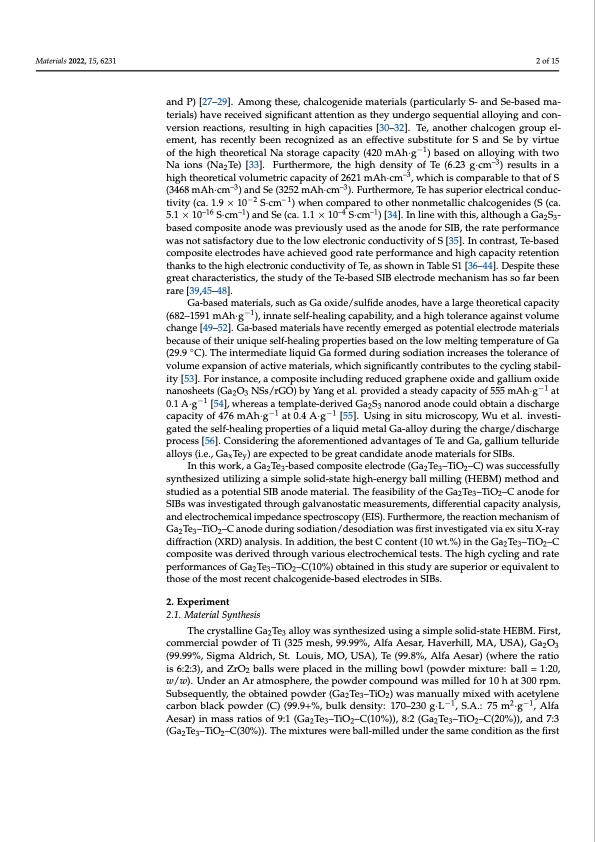
PDF Publication Title:
Text from PDF Page: 002
Materials 2022, 15, 6231 2 of 15 and P) [27–29]. Among these, chalcogenide materials (particularly S- and Se-based ma- terials) have received significant attention as they undergo sequential alloying and con- version reactions, resulting in high capacities [30–32]. Te, another chalcogen group el- ement, has recently been recognized as an effective substitute for S and Se by virtue of the high theoretical Na storage capacity (420 mAh·g−1) based on alloying with two Na ions (Na2Te) [33]. Furthermore, the high density of Te (6.23 g·cm–3) results in a high theoretical volumetric capacity of 2621 mAh·cm–3, which is comparable to that of S (3468 mAh·cm–3) and Se (3252 mAh·cm–3). Furthermore, Te has superior electrical conduc- tivity (ca. 1.9 × 10−2 S·cm– 1) when compared to other nonmetallic chalcogenides (S (ca. 5.1 × 10–16 S·cm–1) and Se (ca. 1.1 × 10–4 S·cm–1) [34]. In line with this, although a Ga2S3- based composite anode was previously used as the anode for SIB, the rate performance was not satisfactory due to the low electronic conductivity of S [35]. In contrast, Te-based composite electrodes have achieved good rate performance and high capacity retention thanks to the high electronic conductivity of Te, as shown in Table S1 [36–44]. Despite these great characteristics, the study of the Te-based SIB electrode mechanism has so far been rare [39,45–48]. Ga-based materials, such as Ga oxide/sulfide anodes, have a large theoretical capacity (682–1591 mAh·g−1), innate self-healing capability, and a high tolerance against volume change [49–52]. Ga-based materials have recently emerged as potential electrode materials because of their unique self-healing properties based on the low melting temperature of Ga (29.9 ◦C). The intermediate liquid Ga formed during sodiation increases the tolerance of volume expansion of active materials, which significantly contributes to the cycling stabil- ity [53]. For instance, a composite including reduced graphene oxide and gallium oxide nanosheets (Ga2O3 NSs/rGO) by Yang et al. provided a steady capacity of 555 mAh·g−1 at 0.1 A·g−1 [54], whereas a template-derived Ga2S3 nanorod anode could obtain a discharge capacity of 476 mAh·g−1 at 0.4 A·g−1 [55]. Using in situ microscopy, Wu et al. investi- gated the self-healing properties of a liquid metal Ga-alloy during the charge/discharge process [56]. Considering the aforementioned advantages of Te and Ga, gallium telluride alloys (i.e., GaxTey) are expected to be great candidate anode materials for SIBs. In this work, a Ga2Te3-based composite electrode (Ga2Te3–TiO2–C) was successfully synthesized utilizing a simple solid-state high-energy ball milling (HEBM) method and studied as a potential SIB anode material. The feasibility of the Ga2Te3–TiO2–C anode for SIBs was investigated through galvanostatic measurements, differential capacity analysis, and electrochemical impedance spectroscopy (EIS). Furthermore, the reaction mechanism of Ga2Te3–TiO2–C anode during sodiation/desodiation was first investigated via ex situ X-ray diffraction (XRD) analysis. In addition, the best C content (10 wt.%) in the Ga2Te3–TiO2–C composite was derived through various electrochemical tests. The high cycling and rate performances of Ga2Te3–TiO2–C(10%) obtained in this study are superior or equivalent to those of the most recent chalcogenide-based electrodes in SIBs. 2. Experiment 2.1. Material Synthesis The crystalline Ga2Te3 alloy was synthesized using a simple solid-state HEBM. First, commercial powder of Ti (325 mesh, 99.99%, Alfa Aesar, Haverhill, MA, USA), Ga2O3 (99.99%, Sigma Aldrich, St. Louis, MO, USA), Te (99.8%, Alfa Aesar) (where the ratio is 6:2:3), and ZrO2 balls were placed in the milling bowl (powder mixture: ball = 1:20, w/w). Under an Ar atmosphere, the powder compound was milled for 10 h at 300 rpm. Subsequently, the obtained powder (Ga2Te3–TiO2) was manually mixed with acetylene carbon black powder (C) (99.9+%, bulk density: 170–230 g·L−1, S.A.: 75 m2·g−1, Alfa Aesar) in mass ratios of 9:1 (Ga2Te3–TiO2–C(10%)), 8:2 (Ga2Te3–TiO2–C(20%)), and 7:3 (Ga2Te3–TiO2–C(30%)). The mixtures were ball-milled under the same condition as the firstPDF Image | Ga2Te3-Based Anodes for Sodium-Ion Batteries

PDF Search Title:
Ga2Te3-Based Anodes for Sodium-Ion BatteriesOriginal File Name Searched:
materials-15-06231.pdfDIY PDF Search: Google It | Yahoo | Bing
Salgenx Redox Flow Battery Technology: Salt water flow battery technology with low cost and great energy density that can be used for power storage and thermal storage. Let us de-risk your production using our license. Our aqueous flow battery is less cost than Tesla Megapack and available faster. Redox flow battery. No membrane needed like with Vanadium, or Bromine. Salgenx flow battery
| CONTACT TEL: 608-238-6001 Email: greg@salgenx.com | RSS | AMP |